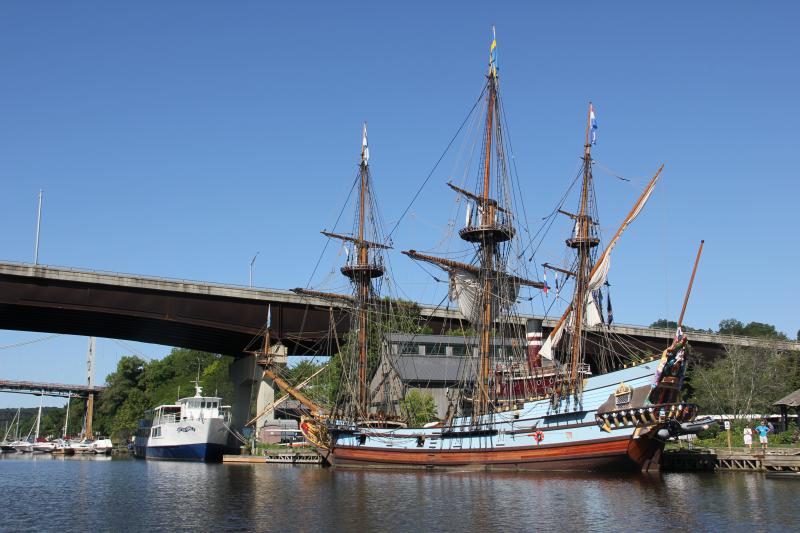Discovering the Hudson River and points north
Becky and I left Lewes aboard Nellie Peach, a 25-foot downeast-style mini trawler, on Aug. 1. Headed north across Delaware Bay and up the coast to New York City; we had set our sights years ago on the Hudson River and points beyond. Now we’re making it happen.
As I write this, 12 days and 333 watery miles later, we are tied up to a floating dock at the Albany Yacht Club in New York State’s capital city. We’re averaging about 8.5 miles an hour, learning how to time the tides in the Hudson to maximum advantage, scouring the banks of the river for the countless points of interest, gathering intel from folks along the way, marveling at grand estates built high above the river’s edge associated with names like Rockefeller and Roosevelt that punctuate the American saga, immersing ourselves in history, culture and geography so different from what we’re used to on Delmarva.
We spent our first night in Ocean City, New Jersey, after traveling the Intracoastal Waterway northward from Cape May. It was good to see the back side of so many Jersey resort towns that previously existed for us only in stories from others and news reports: Wildwood, Ocean City, Atlantic City, Asbury Park, Manasquan, Brigantine, Brighton and then the Highlands just below Sandy Hook that gave us a taste of what lay ahead in terms of changing topography.
Greenhead flies ate me alive as we passed through the endless summer-colored marshes between Cape May and Ocean City. A sailing instructor at Ocean City Yacht Club named Brown Baer - truly, Brown Baer - advised us to run outside from Ocean City to Manasquan. “You’ll make better time and have fewer bridges to contend with. Plus no greenheads.”
He was right. The ocean was flat as a lake. We made much better time and covered a lot of ground before turning into Manasquan Inlet and our second night, at Hoffman’s Marina in Brielle, just west of Manasquan. All towns in Jersey seem to connect with other towns, inland as well as along the coast.
We tied up alongside a railroad bridge over the Manasquan River. That was where we first started developing a relationship with the trains that are such a constant feature of the Northeast corridor - their whistles, their rumblings, the bells that ring at highway crossings.
Beyond Manasquan, we anchored up little creeks in towns as small as Catskill, in New York, and in cities as sprawling and pulsing with energy as New York City. Chronologically, in addition to those I already mentioned, those stops included anchorage in Sandy Hook Bay at the northern tip of the Jersey coast, two nights dockage at the 79th Street Boat Basin in Manhattan, a mooring ball at Nyack Boat Club in Nyack, Washington Irving Boat Club in Tarrytown, Riverfront Marina in Newburgh, another mooring ball at Poughkeepsie Yacht Club north of Hyde Park, an afternoon at the public dock in Kingston, an anchorage in Catskill Creek and today in Albany.
Enough of the laundry list; you get the picture.
On the river, we’ve shared the waterway with vessels from kayaks to container ships and everything in between, including ferries, sloops, Jet Skis and tug-pushed barges loaded with cement, gravel, fuel and other commodities.
The Hudson’s shoreline is dotted with small and unpretentious yacht clubs where groups of people in decades past pooled their resources to buy a piece of riverfront property where they could build docks for their boats and little clubhouses for socializing and more intimate interaction with the river. The people are welcoming and usually reserve a few slips or spaces at floating docks for transient boaters passing through. We’ve enjoyed endless dockside conversations and gathered lots of recommendations in the process.
We often find connections to Delaware’s Cape Region. When we turned into the creek that leads to Kingston - New York’s first capital - I saw a blue-hulled vessel tied up in the middle of the town’s waterfront. A tall ship. Sure enough, the Kalmar Nyckel, Delaware’s tall ship, home port Wilmington.
People were lining up to buy tickets for a sailing tour aboard the vessel when I spoke with helmsman Ed Rush.
“We had to come all the way from Lewes to see the Kalmar Nyckel this year,” I told him.
Ed’s face went hangdog. “We truly, truly regret not being able to go into Lewes anymore. That was always one of our favorite ports. The people are great - just a fun place to be. But there’s not enough water at the ferry terminal anymore. Too much sand. A million dollars to dredge it out, and then it will just come back again. And the same in town. I remember our first captain, David Hyatt, would push through mud to get to the town dock there, even at high tide. Can’t do that anymore either.”
Rush eyed Catskill Creek as we spoke. His mind was shifting to the tricky maneuvering needed to get the big tall ship out of that deep and narrow creek for the Hudson sail.
Navigating on the Hudson and its tributaries. A lot to fill the mind.
By the time you’re reading this, we will have hopefully made our through the 12 locks of the Champlain Canal that connects the upper Hudson with Lake Champlain.
For those wanting more pictures and narrative, check out my Hudson River Sojourn blog at www.capegazette.com. Thanks for reading.




























































